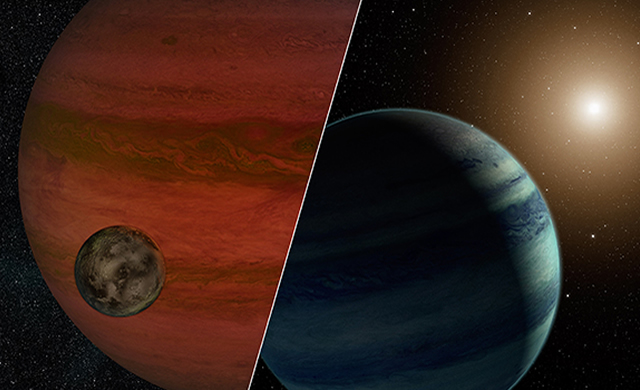
Credit: NASA/JPL-Caltech
Titano, Europa, Io e Phobos sono solo alcuni dei membri del pantheon di lune del nostro sistema solare. Ci sono altre lune là fuori, in orbita attorno a pianeti oltre il nostro sole? Ricercatori sostenuti dalla NASA hanno individuato i primi segni di una “esoluna” med anche se dicono che è impossibile confermare la sua presenza, la constatazione è uno stuzzicante primo passo per individuarne delle altre. La scoperta è stata fatta guardando un incontro casuale di oggetti nella nostra galassia a cui si può assistere solo una volta. “
Non avremo la possibilità di osservare di nuovo il candidato esoluna”, ha detto David Bennett della University of Notre Dame, nell’Indiana, autore di un nuovo documento su questi risultati apparsi sull’Astrophysical Journal. «Ma possiamo aspettarci reperti ancora più inaspettati, come questo. ” Lo studio internazionale è guidato congiuntamente da Giappone, Stati Uniti e Tasmania, utilizzando i telescopi in Nuova Zelanda e in Tasmania. La loro tecnica, chiamata microlensing gravitazionale, si avvale di allineamenti casuali tra le stelle. Quando una stella di primo piano passa tra noi e una stella più lontana, la stella più vicina può agire come una lente di ingrandimento per mettere a fuoco e illuminare la luce di quella più lontana. Questi eventi di “schiarimento” di solito durano circa un mese. Se la stella di primo piano, o quello che gli astronomi chiamano “obiettivo”, ha un pianeta che gira intorno ad esso, il pianeta agirà come una seconda lente per potenziare oppure oscurare la luce, in maniera più sensibile. Scrutando con attenzione questi eventi gli astronomi possono capire la massa della stella in primo piano rispetto al suo pianeta. In alcuni casi, tuttavia, l’ oggetto in primo piano potrebbe essere un pianeta fluttuante, non una stella. I ricercatori potrebbero quindi essere in grado di misurare la massa del pianeta rispetto al suo compagno orbitante: una luna . Mentre gli astronomi che sono impegnati nella ricerca di lune extrasolari utilizzando i dati della missione Kepler della NASA, finora non ne hanno trovato alcuna. Nel nuovo studio, la natura dell’oggetto di primo piano, non è chiara. Il rapporto tra il corpo più grande e la sua compagna più piccola è di 2.000 a 1, ciò significa che la coppia potrebbe essere una piccolo, debole stella circondata da un pianeta di circa 18 volte la massa della Terra, o un pianeta più massiccio di Giove accoppiato con un luna di peso inferiore alla Terra.
Titan, Europa, Io and Phobos are just a few members of our solar system’s pantheon of moons. Are there are other moons out there, orbiting planets beyond our sun? NASA-funded researchers have spotted the first signs of an “exomoon,” and though they say it’s impossible to confirm its presence, the finding is a tantalizing first step toward locating others. The discovery was made by watching a chance encounter of objects in our galaxy, which can be witnessed only once.
“We won’t have a chance to observe the exomoon candidate again,” said David Bennett of the University of Notre Dame, Ind., lead author of a new paper on the findings appearing in the Astrophysical Journal. “But we can expect more unexpected finds like this.” The international study is led by the joint Japan-New Zealand-American Microlensing Observations in Astrophysics (MOA) and the Probing Lensing Anomalies NETwork (PLANET) programs, using telescopes in New Zealand and Tasmania. Their technique, called gravitational microlensing, takes advantage of chance alignments between stars. When a foreground star passes between us and a more distant star, the closer star can act like a magnifying glass to focus and brighten the light of the more distant one. These brightening events usually last about a month. If the foreground star or what astronomers refer to as the lens has a planet circling around it, the planet will act as a second lens to brighten or dim the light even more. By carefully scrutinizing these brightening events, astronomers can figure out the mass of the foreground star relative to its planet. In some cases, however, the foreground object could be a free-floating planet, not a star. Researchers might then be able to measure the mass of the planet relative to its orbiting companion: a moon. While astronomers are actively looking for exomoons for example, using data from NASA’s Kepler mission – so far, they have not found any. In the new study, the nature of the foreground, lensing object is not clear. The ratio of the larger body to its smaller companion is 2,000 to 1. That means the pair could be either a small, faint star circled by a planet about 18 times the mass of Earth or a planet more massive than Jupiter coupled with a moon weighing less than Earth.
Source/Continue reading → NASA.gov





















